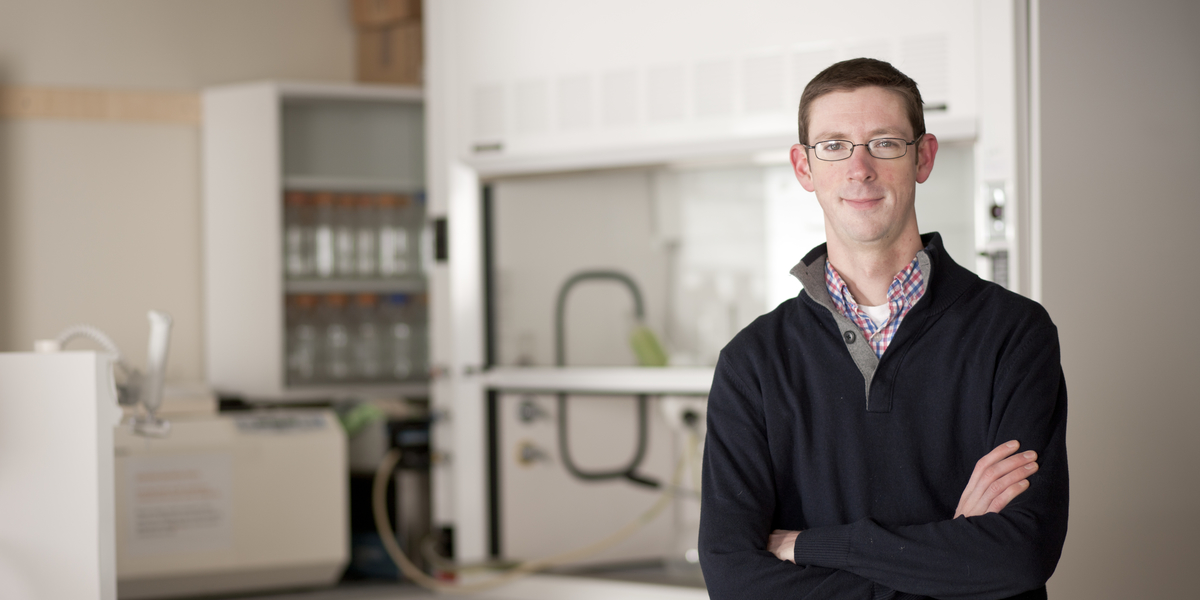
The role of E. coli in causing food-borne illness is well known. Less well known, however, is the way microbes interact with each other. Like humans, they exchange resources and live in communities. Understanding these complex interactions could help scientists predict and even control the properties of a microbial community—yielding new tools for treating infections, promoting human and animal health, and improving soil productivity.
Will Harcombe, an associate professor of Ecology, Evolution and Behavior and a member of the BioTechnology Institute, studies microbial interaction by looking at the exchange of chemicals among microbial species. “One of the fundamental ways [microbes] can influence each other is just by taking up and releasing chemicals into the environment,” he says. “Will they compete by trying to eat the same resource? Or will they facilitate each other by one secreting a product that helps another?”
Model Behavior
To make sense of microbial interactions, Harcombe starts with a model of how he expects microbes to interact. At its core, a model is a tool that describes how the output of a system depends on its inputs. Harcombe’s models consist of equations that relate the abundance of two microbial species, the output, to defined inputs like available nutrients and spatial distribution. Using the model, he can test what happens to the abundance of two microbial species when placed in an environment with defined nutrients. Importantly, this allows him to observe what the microbes do when they interact in the ways he suspects.
After generating computer-based results, Harcombe replicates this experiment in the lab. Harcombe places two or more species of microbes together and tracks the resources they exchange. At the same time, he observes population-level characteristics such as growth rates, colony shape and species abundance. By simultaneously monitoring resources and community traits, he can answer questions about the spatial organization, the ratio between species and how available nutrients impact the exchange of resources.
Sometimes experiments align with the results generated by his model. In other cases, they differ from — or even contradict — the model.
Two-Species Surprise
In one study, Harcombe and his colleagues wanted to investigate the dynamics between two microbial species, each of which depends on the other for survival. One (E. coli) was modified to require a nutrient—methionine—produced by the other (S. enterica). S. enterica, for its part, needs acetate excreted by E. coli.
One might expect these microbial colonies would thrive when cultured together — and when cultured alone, neither would make it. Per his computer model, that’s precisely what happened. When cultured in the lab, he saw the same results.
Then came a surprise. In the lab, Harcombe introduced a virus that infects one species but not the other. Because each species’ survival depends on the other, Harcombe expected that infection would impact both.
When he introduced a virus that only infected S. enterica, his prediction was spot on. When he introduced a virus that only infected E. coli, he ended with fewer E. coli as predicted, but surprisingly, he also found more S. enterica relative to pre-infection numbers. What was he missing?
Answering that question experimentally would have required painstaking tests, altering one variable at a time until he understood what was happening. While that approach might eventually provide an answer, it would be costly. Without knowing which explanations were plausible, Harcombe could spend years testing possible mechanisms responsible for the odd result.
Productive Insights
Enter modeling. If the microbes weren’t behaving the way he expected, there must be something else; different metabolites or different types of interactions to explain the observations. So rather than running experiments to identify the mechanisms at play, Harcombe put those possibilities into the model. Once he found a model approximating his observation, he could confirm his conjecture with additional experimentation.
Harcombe suspected some E. coli developed resistance to the virus, protecting them from extinction. He further postulated that others would burst and release a wealth of nutrients. Together, they might provide an abundance of the acetate S. enterica need to thrive. Incorporating these mechanisms into his model yielded results that closely mirrored the experimental model.
“The biggest surprise to me in this study is that bacteria could get the elements they needed from other species by eating the dead,” says Harcombe.
Back in the lab, Harcombe ran additional experiments to test the model. For the most part, they supported his hypothesis. The only thing missing was a second consequence of E. coli developing a resistance to the virus. Virus-resistant E. coli produced more acetate than their nonresistant counterparts.
Harcombe is pleased with the way the experiment-plus-model approach has boosted his ability to solve microbial mysteries, and how the solutions stand to benefit humanity. Harcombe and colleagues use these models to predict how microbes respond to antibiotics and engineer interactions into microbial communities in soils to render crops more resilient to a changing climate. “Going forward, I’m really optimistic that we will be able to continue to develop our understanding of fundamental processes and apply it in these different areas.”
- Bernard Cook III